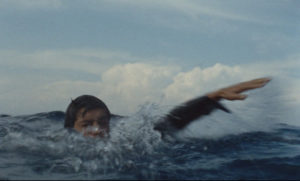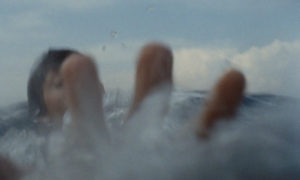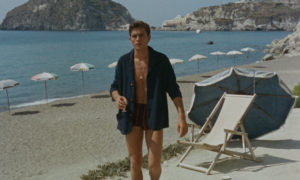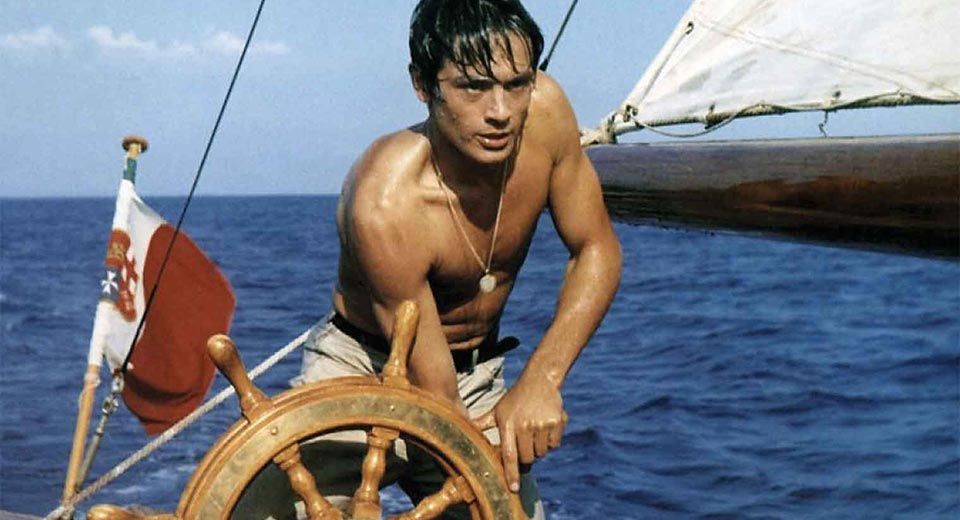Murder isn’t something people take lightly, especially if the murderer is lounging out on the beach enjoying a cocktail. In the colorful 1960’s film Plein Soleil, or in English Purple Noon, directed by René Clément, this is precisely what Alain Delon’s character, Tom Ripley, spends his time doing. Alain Delon was seen as a prominent sex symbol of the 1960s, and was only 25 years old during the film’s shooting. I have to say for myself, I think he’s quite handsome, but you definitely shouldn’t just watch the film for Delon. There is scandal, love, jealousy, and an elaborate murder plan involved, all presented beautifully in vibrant color.
The film was based on the 1955 novel The Talented Mr. Ripley, written by Patricia Highsmith. An American version of the movie came out in 1999, directed by Anthony Minghella, starring Matt Damon. The plots are almost the same as from the novel and the French adaption. We presume in the film that Mr. Ripley is heterosexual because he wants to be with his friend’s fiancé, Marge Duval (Marie Laforet). Yet, there is speculation that there are some queer vibes coming from him. Ripley is jealous of his friend, Philippe Greenleaf (Maurice Ronet), and desires to take over Philippe’s life entirely to inherit his decadent lifestyle. Yet, it could be that Ripley wants to become Mr. Greenleaf not out of jealousy, but out of oblique lust and attraction. I won’t be diving into the theory myself, but it certainly is an exciting take on Ripley’s motives. In the novel, there is a background story on Tom’s childhood, but we start well into his later years in the film adaption. We are thrown into the film’s narrative and have to guess precisely where the story left off when we join. The abrupt start is countered by Delon’s charming personality that fills in the gaps and slowly catches us up.

Tom copying signatures in the very beginning, though we’re not sure why.
Purple Noon was shot on location in various places in Rome and Italy. The fictional town Mongibello, where most of the film takes place, was filmed around Naples, Italy. The location adds an exquisite touch to the storyline. Ripley is portrayed as a smart, sophisticated man, and he stays in extravagant hotels and apartments that model after him. If you get the chance to watch the film, you’ll notice the passersby will stare and look directly at the camera. The stares confirm that a sound stage wasn’t used, as well as being shot without having to block off streets and interfering with the hustle and bustle of Italian life. The setting was as real as a setting could get. Unlike the other films we have covered so far, this film is in color. The characters wear bright pastels and stand out against the light blue sky. Delon’s eyes are also a pop of color with his icy blues.

A man at the market looking directly into the camera.
Most of the first half of the film takes place on Greenleaf’s yacht. If you get sea-sick quickly, this part may induce some sickness. The camera follows along with the water as it ebbs and flows with the boat. Greenleaf tries to play a harmless prank on Tom by putting him on the buoy and letting him float behind the boat for a while, while he and Marge have some fun in the cabin. The buoy becomes unhitched and floats away, leaving Tom stranded in the middle of the ocean with a bad sunburn and severe dehydration. Greenleaf and Marge manage to find Tom and rescue him, but to Tom, that was the last straw. Tom reveals his plan to kill Greenleaf jokingly but directly to him after the sunbath. When Tom finally does commit the murder, the wind and the waves get louder and creates chaos, producing feelings of anxiety as Tom almost loses grip of the boat trying to throw Greenleaf’s body in the ocean.

Tom struggling to grab on to the boat.

Tom struggling to grab on to the boat.
Throughout the last half of the film, we see Tom’s con man come to life. He creates a realistic passport photo of himself in his hotel room in place of Greenleaf’s. He also practices Greenleaf’s signature for hours with a projector screen. After he finally smoothes out all of the wrinkles in taking over Greenleaf’s identity, he cons up how to trick Marge into thinking Greenleaf murdered his friend (Billy Kearns)–who Tom murdered, since he was catching on–and then committed suicide. He manages to slip past police officers and Greenleaf’s friends who are staying in the same city. The story keeps you on edge with how many close calls Tom manages to escape.
By the end, Tom is finally off the hook with a fake suicide note working and the police off his tail with the murder of Greenleaf’s friend – or so we think. Marge slowly starts to fall for Tom, and they begin a relationship. Marge goes to a meeting with Greenleaf’s father about selling the yacht, but when they pull the boat out of the water, they find Greenleaf’s body, tangled in the ship’s back propellers since it never sank to the bottom of the ocean. As Tom sips a cocktail on the beach as he waits for Marge to come back, the police find him and the film ends, Tom walking towards the policemen. The ending is highly debated as to whether the film should have ended like that or if the conclusion should have been kept like the ending in the book, where Tom gets away with everything. While it isn’t as happy as we may want it to be, –like most of the French New Wave film endings we have covered so far– a less-than-perfect ending puts a stop to his mastermind plan and satisfies our wonder for the “what ifs.”

Tom walking toward the police for a “phone call.”
Purple Noon is the only film I will cover from Clément. The film is extraordinary enough to be considered the only Clément film worth analyzing among all of his other features, if we had to pick and choose. He creates a realistic world for us to believe that someone out there could do what Tom does. His confident choice in the resolution demonstrates his capability to understand that human desires cannot always be fulfilled. Even if you’re a brilliant mastermind, the drip has to stop, making this piece an excellent addition to our journey into La Nouvelle Vague.


Recent Comments